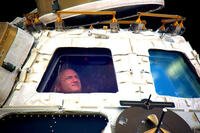In the late summer of 1990, the forces of Iraqi dictator Saddam Hussein were poised on the Saudi border, having just overrun Kuwait. U.S. troops scrambled to get ashore and fall in on their gear, overcoming chaos at the Saudi ports.
Five months later, on Jan. 17, 1991, U.S.-led coalition bombings of Hussein's Iraq began, and Operation Desert Shield -- a six-month buildup of troops and defensive mission -- became the kinetic Operation Desert Storm. It was the start of what has been described by the Government Accountability Office as "perhaps the most successful war of the 20th Century."
More than 500,000 U.S. troops deployed to Saudi Arabia during Desert Shield, preparing the way for Desert Storm.
In a virtual briefing held ahead of Desert Storm's 30th anniversary, analysts with the Center for Naval Analyses who had been embedded during the fight revisited the war and the elements that had made it such a successful U.S. operation.
Read Next: Army IDs 1st Armored Division Staff Sergeant Found Dead at Fort Bliss Home
Analysts pointed to the contributions of the battleships Missouri and Wisconsin in their last war, and stressed that the first test of the "total force" concept relying on the reserves succeeded beyond the expectations of commanders.
Steve Karppi, a senior CNA researcher who was embedded with Cruiser-Destroyer Group 2, said the battleships "were using remotely piloted vehicles to do their targeting" with their fearsome 16-inch guns. "That was a new development."
The second time the battleships unleashed bombardments, the Iraqis "actually tried to surrender," Karppi said. "The drone saw it. The Iraqis put up white flags. It appears the Iraqis were fearful of that bombardment and they actually surrendered."
During the air campaign, the U.S. and its allies conducted more than 116,000 combat air sorties and dropped 88,500 tons of bombs, according to the Defense Department. The six-week air campaign set the stage for the 100-hour ground assault that routed Iraqi forces and liberated Kuwait.
"Beginning at 0239 [hours] on Jan. 17, 1991, a Coalition air armada of nearly a thousand aircraft in the first day of the air campaign attacked more targets than all of the Eighth Air Force aircraft hit in the entire European theater during the years 1942 and 1943," the Air Force Association's Mitchell Institute for Aerospace Studies stated in a report titled "Desert Storm: 30 Years Later."
Mark Geis, executive vice president of CNA, who was embedded with the 2nd Marine Expeditionary Force, said that Desert Shield and Desert Storm "really validated the effectiveness of an all-volunteer force," and proved that the active-duty units could rely on the reserves for specialized skills in intelligence, maintenance and logistics, search and rescue, and construction.
It was the first real test of the total-force concept involving shifting major responsibilities to the reserves, Geis said. "Each one of the services did it pretty aggressively," he said, although "there were some questions about whether the reserve was going to be able to perform."
However, the reserves "were able to execute extremely effectively, and so that [total force] concept was validated," Geis said.
As for lessons learned, Karppi and CNA President and CEO Katherine McGrady said Desert Shield and Desert Storm highlighted the need for military planners to pay more attention to the threat of mines on land and at sea, which remain a major problem for an attacking force.
Karppi said the Iraqi mines in the Persian Gulf, mainly bottom-mounted, "were an issue for sure for the Navy." Mines caused serious damage to the amphibious ship Tripoli and major damage to the cruiser Princeton, Karppi said.
Mines were also "a big issue for the Marine Corps," said McGrady, who was embedded with the 1st Marine Expeditionary Force. "What amazed me in my observation -- something like mines, such an unsophisticated device, can really disrupt plans. Even the perception that they might be out there causes an enormous amount of disruption."
In a later interview with Military.com, McGrady said the dangers from mines and improvised explosive devices persisted through the wars in Afghanistan and Iraq, and warned that "the very threat of mines can bring an operation to its knees."
-- Richard Sisk can be reached at Richard.Sisk@Military.com.
Related: Why 50-Year-Old Battleships Were a Critical Part of Operation Desert Storm













